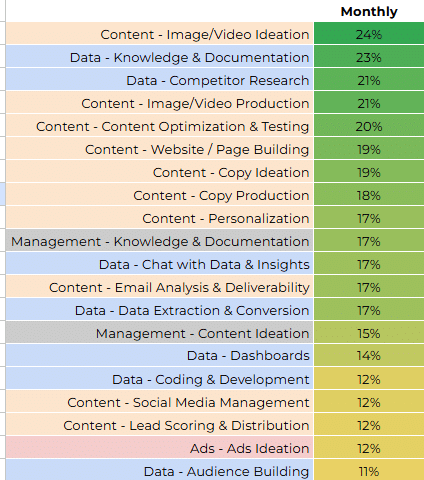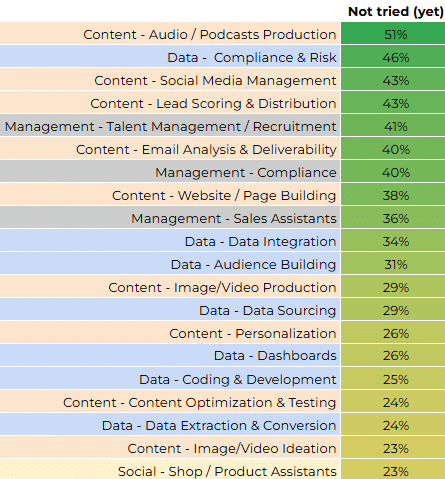
As genAI adoption accelerates, organizations must go beyond the hype to determine which use cases deliver real value. To provide clarity, we at MartechTribe surveyed 283 marketing professionals — including CEOs, consultants, marketing directors and operations managers — to understand how frequently marketers use different genAI applications.
The use cases analyzed were carefully selected from our Martech Supergraphic, which tracks trends in marketing technology. In 2024, 2,324 genAI tools accounted for 77% of growth in the marketing technology landscape, highlighting AI’s significant industry impact. However, adoption patterns vary: some use cases are deeply integrated into daily workflows, while others remain largely aspirational.
Insights based on the 6 main martech functions
The survey results highlighted distinct patterns across the six key martech categories from the Martech Map:
- Ads.
- Content.
- Social.
- Sales.
- Data.
- Management.
Among these, content and data use cases dominated the top 20, while ad-related use cases struggled to gain traction.

1. Content takes center stage
Content-related genAI applications (orange) lead the pack, with seven of the top 20 use cases focusing on content ideation, production and optimization. Marketers rely heavily on genAI to streamline workflows, enhance personalization and keep up with the increasing demand for high-quality content.
The top content use cases are:
- Copy ideation (50.7%): GenAI is extensively used to brainstorm and generate fresh ideas.
- Copy production (43.9%): Automation plays a major role in drafting content across multiple formats.
- Content optimization and testing (28.6%): Marketers use AI to refine content performance.
Dig deeper: 3 marketing use cases for generative AI that aren’t copywriting
2. Data as a strategic driver
Data-related applications (blue) are also prominent, with six of the top 20 focused on focused on knowledge management, competitor research and documentation. GenAI’s ability to analyze vast amounts of data and extract actionable insights is a key driver behind its popularity.
The top data use cases cover sources other than customer data.
- Knowledge and documentation (22.5%): AI supports the organization and retrieval of critical marketing data.
- Competitor research (21.4%): GenAI helps marketers stay ahead by analyzing competitor strategies.
3. The adtech adoption gap
Despite the strong presence of advertising (red) in digital marketing, genAI adoption in this area remains low. The highest-ranked ad application appears at position 28, with seven of the bottom 23 falling under adtech. Several factors may explain this gap.
- Outsourcing: Many marketers rely on agencies and external partners for ad production, limiting their direct interaction with genAI tools.
- Embedded AI: Google Ads’ Performance Max and Facebook’s Advantage+ automate ad optimization without marketers actively realizing the role AI plays.
- Creative control: Marketers may be hesitant to delegate creative decision-making to AI.
Dig deeper: Unlock the real value of genAI in martech
4. Social and management: Two mixed bags
Social and management use cases (yellow and grey) show divergent trends in adoption. While some applications enjoy high adoption, others remain underutilized.
For social, analytics and scheduling tools are widely used, while AI-driven community engagement and influencer management face resistance.
In management, transcription and summarization tasks see high adoption, boosting productivity, but talent management and recruitment tools remain largely untapped.
5. Sales: Selective integration
Sales-related genAI use cases (green) are applied selectively, mainly in lead scoring and customer segmentation. Marketers seem to prefer AI for data-driven insights rather than automating the sales process entirely, emphasizing the continued importance of human involvement.
Dig deeper: 6 ways to use generative AI for your marketing
Insights based on usage frequency
In terms of monthly usage, the survey shows that genAI typically supports strategic plannng and specialized tasks, whereas daily and weekly use cases are more operational and production-focused.

The top monthly-used genAI applications include:
- Content: Image/video ideation (24.3%).
- Data: Knowledge and documentation (22.5%).
- Data: Competitor research (21.4%).
- Content: Image/video production (21.1%).
- Content: Content optimization and testing (20.0%).
These tasks are typically more complex and resource-intensive, requiring periodic effort rather than daily execution. They support content planning cycles, strategic insights and campaign-level optimizations rather than day-to-day operations.
Daily and weekly use cases primarily focus on content creation and management, such as:
- Copy ideation (50.7%).
- Copy production (43.9%).
- Transcription, notes, summaries (43.2%).
These functions are highly repetitive and integrated into regular workflows, reflecting an ongoing need for speed and efficiency in marketing execution.
Some use cases, such as Content: Image/video ideation (6.1%) and Content: Lead scoring and distribution (3.2%), have seen initial adoption but were eventually abandoned, possibly due to challenges in ROI realization, integration complexity or shifting priorities.
Insights from the ‘wishlist’
The survey data highlights clear patterns in genAI use cases that respondents have yet to try, offering insights into marketers’ aspirations and hesitations.
Based on the responses, these use cases fall into three categories.

High interest (wishlist use cases)
These are the areas where a significant number of respondents (40% or more) have indicated they haven’t tried the use case yet but are likely interested in exploring it in the future.
The following use cases may require more education, proof of value and tool accessibility to encourage adoption. These use cases represent emerging opportunities with strong potential demand.
- Content: Audio/podcasts production (51.4%).
- Data: Compliance and risk (46.4%).
- Content: Social media management (43.2%).
- Content: Lead scoring and distribution (42.5%).
- Management: Talent management/recruitment (41.1%).
Moderate interest (some tried, many still interested)
This group includes use cases with a moderate level of respondents (20-40%) who haven’t tried them yet but may still be interested. These areas may see gradual adoption as more case studies and successful implementations become available.
The following areas may be considered valuable but could have barriers such as complexity, budget constraints or competing priorities:
- Content: Website/page building (38.2%).
- Management: Sales assistants (36.1%).
- Data: Audience building (31.4%).
- Content: Image/video production (29.3%).
- Data: Data sourcing (28.9%).
Few interested (lower priority use cases)
A smaller percentage (below 20%) of marketers have expressed interest in these use cases, suggesting they may not currently see them as critical to their operations. To gain traction, these use cases may require stronger value propositions or better alignment with marketing priorities.
- Ads: Brand safety (17.9%).
- Social: Customer service and support (14.6%).
- Sales: Pipeline optimization (12.9%).
- Ads: Video ads creation (12.5%).
- Management: Knowledge and documentation (11.4%).
Dig deeper: 4 marketing ‘jobs to be done’ being transformed by genAI
The post The top 50 genAI use cases in marketing appeared first on MarTech.
